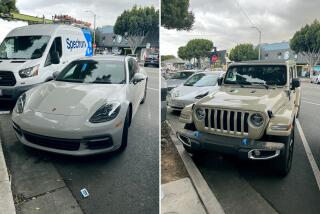AROUND HOME : Ford Taurus
“YOU CAN HAVE IT in any color you like as long as it’s black,” said Henry Ford of the Model T, setting the precedent for his company’s vaunted conservatism. Indeed, Ford is still stamping out its boxy Lincoln Town Car, little changed in a decade and boasting an interior trimmed with tacky wood-grained plastic.
Yet now, Ford’s bread-and-butter entry in the family-car field is stylish Taurus, introduced in 1985. With the Taurus, Ford finally one-upped GM, traditionally the styling leader, by winning mention on Fortune Magazine’s 10 best-designed American products list and becoming the best-selling car in its class. And the bulbous Taurus station wagon--in black, of course--has become a stylish, mid-range station wagon choice among Southern Californians, including the trendy design community.
Ford’s vice president of design Jack Telnack, an alumnus of Art Center College of Design in Pasadena, recalls that the managers were serious about wanting something really different. The new model was to appeal to yuppie buyers not affluent enough for a BMW but appreciative of European styling and instrumentation. Indeed, the Taurus bears a striking resemblance to the German-made Audi 5000. Says Telnack: “We started work on ours before theirs came out. We have a softer, more aerodynamic shape and better-integrated bumpers.”
The Taurus’ “aero” looks appeal to the pocketbook as well as to the eyes, because the reduction in wind resistance means that the engine burns less gas. (On the other hand, the rounded profile and windows mounted flush to the body, without protruding trim, have won the Taurus nicknames such as “jellybean” and “bathtub.”)
To enhance aerodynamics further, Telnack dispensed with the grille entirely; air cools the engine by traveling through ducts under the bumper. Reportedly, the grille was the biggest single design decision, perhaps because no part of a car’s anatomy has been as touchy to Ford management since the ill-fated Ford Edsel. The Edsel’s odd vertical grille, likened to an anteater’s snout, contributed to the car’s demise in 1962--at the time the costliest fiasco in American corporate history. Luckily, this time Ford indeed “had a better idea.”




